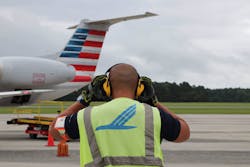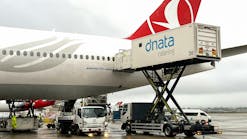How Automated Scheduling Can Reinforce Airline Productivity
When Brian Wemple, director of planning and support for regional air carrier Piedmont Airlines, Inc., first came to his current role several years ago, the airline was looking to take a next step with scheduling. Wemple, who’s worked for 20 years at the airline in various roles beginning as a manager of ground equipment inventory, leads the airline’s group tasked with planning the resource provisioning for ground handling.
Previously, there wasn’t a system-level way to do shift scheduling, run reports and know how many hours the airline’s regional stations were using. The steps involved in creating a suggested shift schedule for ground handling workers were not automated.
Piedmont, a wholly owned subsidiary of the American Airlines Group, includes a fleet of 58 Embraer-145 regional jets and approximately 9,200 employees, including 6,000 ground handling personnel.
The regional air carrier’s managers had to print out and post schedules in break rooms as well as manage paper forms to assist employees in bidding on and swapping shifts, along with tracking seniority to comply with rules for processing bids and swaps.
Using a seniority system, employees could then bid on and trade shifts. Inevitably, employees asked for exceptions. One person might sign up for a half-shift swap and wait for someone to take the other half; employees would frequently check back to see if the swap made it into the schedule book. All the while, managers and administrative staff at the different stations tried to stay on top of schedules, changes, requests and more. Adding to the complexity of staffing were local management teams across Piedmont’s 72 sites – each handling scheduling in their own way.
A Plan for Improving Consistency and Dependability
According to Wemple, there were two drivers for automating crew scheduling and shift swaps at Piedmont. First, the airline wanted to consistently manage schedules for ground staff. And, second, Piedmont sought a capability to report on employee dependability or how often workers were accepting shifts. Wemple also saw ground crew scheduling software as one way to reduce flight delays and boost profitability.
Gaining consistent reporting and a common employee roster were critical for the airline to better analyze whether it was deploying equipment and people optimally for day-of-operations. While Piedmont’s staff management software takes day-of-flight schedules and generates work assigned to employees, without a platform for a common shift, there was no way for Wemple’s team to use its staff management software’s capability for bringing in data for employees on duty.
Piedmont relies on its staff planning software, among other systems, to forecast and adjust staffing levels — e.g., Piedmont typically schedules four to seven employees for each aircraft on the ramp — to meet multiple load-factor assumptions. American Airlines’ headquarters regularly creates proposals for future flight schedules and its team brings those proposals into the staff planning software to run the proposed flight schedules against the ground handling staff requirements to come up with headcount for each Piedmont location. The airline’s planning and support team takes flight schedules and inputs data from Piedmont location managers and creates a utilization plan aligned to a budget and operations.
The staff planning software systems help prepare operations from a staffing perspective by looking at the headcount Piedmont needs and the times of day. That takes the air carrier to a suggested work schedule.
An Automated Ground Crew Scheduling Solution Empowers Workforce
After internal analysis, Wemple happened to be at an industry conference where he met a JetBlue manager and asked how the airline was handling staffing issues. Wemple learned they had a software suite for staffing called ARCOS RosterApps.
Piedmont did its due diligence and implemented ARCOS RosterApps for a subset of its 72 locations to generate a schedule based on the different work groups across ground handling. The software also gave Wemple’s team a near-systemwide look at how bidding on work was aligning with flight schedules.
Over a few years, the developers of ARCOS RosterApps expanded the platform’s capabilities and Piedmont rolled out the software systemwide to integrate it with the software systems for flight operations and day-of-operations. With the rostering solution in place, Piedmont had a consistent source for decision-making about how the airline deployed ground handling personnel. What’s more, local managers were able to get away from using Excel spreadsheets and an Access database, which Wemple described as “a complete hodgepodge.”
Now when headquarters develops a schedule, Wemple provides that to his local operations groups and they fine tune it for what works best for them. The schedule isn’t fully optimal at that point. Wemple’s team then puts the schedule, along with the requisite workplace rules, into ARCOS RosterApps for employees to bid on. With the employees’ preferences locked into the software suite, the planning and support group can help the airline analyze schedules, and see potential shortfalls or overages in staffing and skills, two to four months in advance.
Wemple’s planners can parse schedules by work groups or skills and quickly see, for example, if too many people are scheduled to run baggage, while there aren’t enough to load or unload bags. When the team spots imbalances, they help local managers understand and ask if an adjustment on the planning side might need to happen, possibly creating a new shift bid.
Real-time Analysis for Shifting Needs
According to Wemple, staff rostering software has reduced the complexity of scheduling for management and administrators while also ensuring employees aren’t working too many hours or consecutive days. The ground crew scheduling platform also verifies that ground handling staff meet the minimum work hours during a given time period.
Wemple says verifying that the right people are in the right place is practically instantaneous. Previously, it could take local managers a couple of hours to check every time. The management of the employees’ schedule is now in the hands of the employee.
Having the flexibility to trade shifts for personal reasons or take advantage of free travel is a hallmark of the industry. Taking the process from bulletin boards to a worker’s hand can be seen as a perk that improves employee satisfaction and retention.
The planning and support group now uses ARCOS RosterApps regularly to analyze, for instance, a current bid for a station by looking at coverage hours and comparing future flight schedules and plane requirements by overlaying the two and seeing the variance. If they note a variance, they can alert operations and suggest a new bid. This would shift coverage, so the station avoids being understaffed.
By quickly filling shifts with the right people and equipment on the tarmac, Piedmont can get planes into the air more efficiently.
Bill Perry, a business analyst for ARCOS LLC, writes about the people and industries using resource and workforce management solutions for shift scheduling and automatically planning for all types of planned and unplanned events. He can be reached at [email protected].





